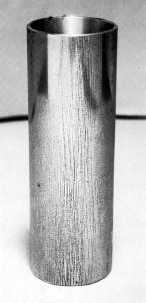T.O. 33B-1-1
3-95
Figure 3-48. Magnetic Particle Indications of Segregations
3.7.4
CLASSES OF DISCONTINUITIES.
There are a number of ways of classifying discontinuities that occur in ferromagnetic materials and parts.
a. One broad grouping is based on location - surface or subsurface. The ability of magnetic particle
inspection methods to find members of these two groups varies sharply. But beyond this, the
classification is too broad to be very useful.
b. Another possible system is to classify discontinuities by the processes that produce them. Although
such a system is too specific to be suitable for all purposes, it is used extensively. We speak of forming
defects, welding defects, heat-treating cracks, grinding cracks, etc. Practically every process, from the
original ore refinement to the last finishing operation, can and does introduce discontinuities which
magnetic particle testing can find. It is therefore important that the nondestructive testing engineer or
inspector be aware of all of these potential sources of defects.
3.7.4.1
Conventional Classification System.
For many years it has been customary to classify discontinuities according to their source or origin in the various stages
of production of the metal, its fabrication, and its use:
a. Inherent: Produced during solidification from the liquid state.
b. Processing: Primary.
c. Processing: Secondary, or finishing.
d. Service.
A discussion of each class with detailed examples is given below.

